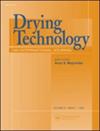An adaptive optimization method toward batch-wise variable set point of outlet moisture content for the tobacco drying process
IF 2.7
3区 工程技术
Q3 ENGINEERING, CHEMICAL
引用次数: 0
Abstract
Abstract The tobacco drying process in the cigarette production has an important effect on the final product quality. Therefore, the intelligent control methods have been widely investigated to ensure the stability of tobacco’s outlet moisture content. The existing work mostly uses a relatively fixed set point of the outlet moisture content for different tobacco batches, which can lead to unforeseen product quality after several processes following the drying process and inaccessible amount of dehydration for the rotary dryer. Some tobacco moisture prediction methods have been studied recently while the relationship with the intelligent control methods remain largely unexplored. To deal with these issues, a novel method is proposed in this paper to identify the optimal set point of the drying outlet moisture content for each tobacco batch. An encoder-decoder model is first developed to forecast the post-drying moisture trajectory. Then, an adaptive filter with specially designed mechanisms and a confidence interval of the dehydration level are constructed to obtain the design constraints. Based on all above, a constrained optimization problem is formulated and solved by the genetic algorithm. Extensive experiments on 895 tobacco batches from a large cigarette factory are carried out, which involves both algorithmic evaluation and field test. It turns out that the proposed method achieves the superior performance and leads to an improvement of the product quality in real production.烟草干燥过程出口含水量批量可变设定点的自适应优化方法
在卷烟生产中,烟叶干燥工艺对最终产品质量有重要影响。因此,为了保证烟草出口水分的稳定,智能控制方法得到了广泛的研究。现有的工作大多是针对不同批次的烟草采用相对固定的出口含水率设定值,这可能导致干燥过程后几道工序的产品质量不可预见,旋转干燥机脱水量难以达到。近年来研究了一些烟草水分预测方法,但与智能控制方法的关系仍未得到充分探讨。针对这些问题,本文提出了一种新的方法来确定每批烟草干燥出口水分含量的最佳设定值。首先建立了一个编码器-解码器模型来预测干燥后的水分轨迹。然后,构造具有特殊设计机制的自适应滤波器和脱水水平置信区间,以获得设计约束。在此基础上,提出了一个约束优化问题,并用遗传算法求解。对某大型卷烟厂的895批烟草进行了广泛的实验,包括算法评估和现场测试。实际生产中,该方法取得了较好的性能,提高了产品质量。
本文章由计算机程序翻译,如有差异,请以英文原文为准。
求助全文
约1分钟内获得全文
求助全文
来源期刊

Drying Technology
工程技术-工程:化工
CiteScore
7.40
自引率
15.20%
发文量
133
审稿时长
2 months
期刊介绍:
Drying Technology explores the science and technology, and the engineering aspects of drying, dewatering, and related topics.
Articles in this multi-disciplinary journal cover the following themes:
-Fundamental and applied aspects of dryers in diverse industrial sectors-
Mathematical modeling of drying and dryers-
Computer modeling of transport processes in multi-phase systems-
Material science aspects of drying-
Transport phenomena in porous media-
Design, scale-up, control and off-design analysis of dryers-
Energy, environmental, safety and techno-economic aspects-
Quality parameters in drying operations-
Pre- and post-drying operations-
Novel drying technologies.
This peer-reviewed journal provides an archival reference for scientists, engineers, and technologists in all industrial sectors and academia concerned with any aspect of thermal or nonthermal dehydration and allied operations.
 求助内容:
求助内容: 应助结果提醒方式:
应助结果提醒方式:


